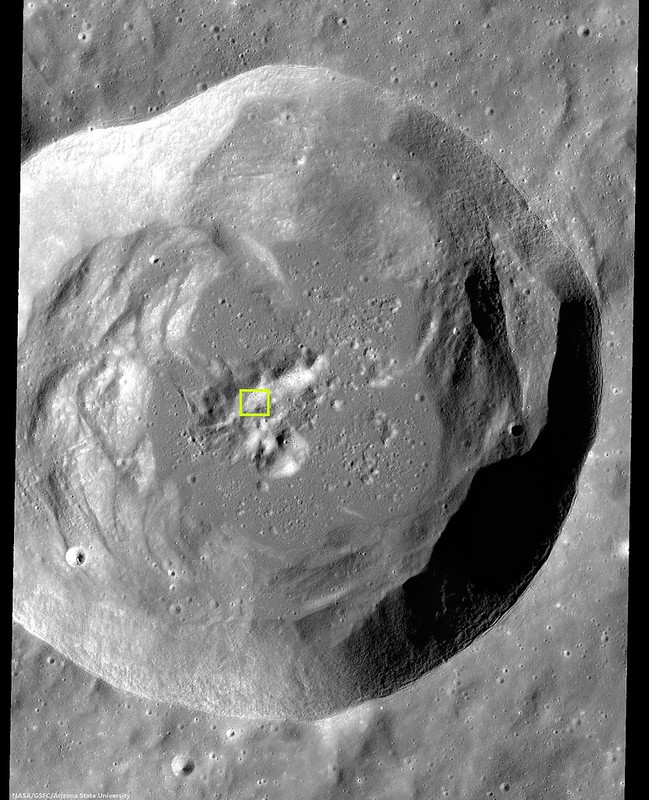 |
| Boulders collect in a small depression right in the middle of the central peak cluster of Steno Q crater (20.063°N, 157.728°E) . Some of these boulders are as big as houses. Field of view 870 meters, portion of NAC controlled mosaic, illumination from the southeast [NASA/GSFC/Arizona State University]. |
J. Stopar
LROC News System
Steno Q is a 32 km diameter crater located in the highland terrain east of Mare Moscoviense. Impact craters, including Steno Q, are formed through a three-stage process consisting of: 1) contact and compression, 2) excavation, and 3) modification.
The initial crater cavity is formed during the excavation stage; during this stage, the excavated material is ejected from the crater, leaving a roughly bowl-shaped void. During modification, the last stage, the shape of the crater cavity adjusts as a function of planetary gravity and scale of impact. For larger impacts, a complex crater shape is formed as a result of a large degree of crater modification: the walls of complex craters slump through gravitational instability, a central peak forms through rebound, and impact melt and debris collect in the crater floor. Typical of other similarly sized Copernican age craters (those younger than 1 billion years), Steno Q preserves a central peak, steep walls with large slump blocks, and a sizeable pond of solidified impact melt rocks covering the lowest parts of the crater cavity.
Explore more complex craters around the Moon at the following LROC Featured Image posts: "Terraces in Eratosthenes Crater," "Not your average complex crater," "Impact melt features in Tycho craters floor," "Aitken Central Peak, Seen Obliquely," "Icarus," "Copernicus Central Peak From The West."
Today's Featured Image closely examines part of the central peak of Steno Q, roughly 10 kilometers wide and consisting of mountains more than 2000 meters high.
The crests of several of these mountains are blocky and composed of highly stressed and fractured materials from the deepest part of the crater. Over time, boulders perched on these steep slopes can roll downhill as a result of seismic tremors and the shaking caused by nearby impacts. A small depression near the middle of the central peak preserves a collection of boulders accumulated from upslope.
Some of these boulders are more than 20m wide -- as big as a house. To get an idea of just how big that is, watch this video, HERE, of Apollo 16 astronauts Charles Duke and John Young approaching similarly-sized "House Rock," on the rim of North Ray crater.
The images in this post were derived from a 1.5 meter per pixel-scale LROC NAC controlled mosaic -- allowing users to explore the entire Steno Q crater, HERE.
Related LROC Posts:
Bouncing, Bounding Boulders!
Boulder trails in Menelaus crater
Rolling Rolling Rolling
Boulder Tales
Bounce, Roll, and Stop
Lazy Boulders in Scaliger Crater
A Recent Journey
LROC News System
Steno Q is a 32 km diameter crater located in the highland terrain east of Mare Moscoviense. Impact craters, including Steno Q, are formed through a three-stage process consisting of: 1) contact and compression, 2) excavation, and 3) modification.
The initial crater cavity is formed during the excavation stage; during this stage, the excavated material is ejected from the crater, leaving a roughly bowl-shaped void. During modification, the last stage, the shape of the crater cavity adjusts as a function of planetary gravity and scale of impact. For larger impacts, a complex crater shape is formed as a result of a large degree of crater modification: the walls of complex craters slump through gravitational instability, a central peak forms through rebound, and impact melt and debris collect in the crater floor. Typical of other similarly sized Copernican age craters (those younger than 1 billion years), Steno Q preserves a central peak, steep walls with large slump blocks, and a sizeable pond of solidified impact melt rocks covering the lowest parts of the crater cavity.
Explore more complex craters around the Moon at the following LROC Featured Image posts: "Terraces in Eratosthenes Crater," "Not your average complex crater," "Impact melt features in Tycho craters floor," "Aitken Central Peak, Seen Obliquely," "Icarus," "Copernicus Central Peak From The West."
 |
| Central peak of Steno Q crater, with the location of the "Bowl of Boulders" shown at high-resolution in the LROC Featured Image indicated by the arrow [NASA/GSFC/Arizona State University]. |
The crests of several of these mountains are blocky and composed of highly stressed and fractured materials from the deepest part of the crater. Over time, boulders perched on these steep slopes can roll downhill as a result of seismic tremors and the shaking caused by nearby impacts. A small depression near the middle of the central peak preserves a collection of boulders accumulated from upslope.
Some of these boulders are more than 20m wide -- as big as a house. To get an idea of just how big that is, watch this video, HERE, of Apollo 16 astronauts Charles Duke and John Young approaching similarly-sized "House Rock," on the rim of North Ray crater.
 |
| Complex crater Steno Q, (32 km, 29.063°N, 157.728°E). Typical of lunar craters of this size, Steno Q underwent extensive crater modification during the impact process, including wall slumping, central peak uplift and impact melt ponding. The box encompasses the field of view in the LROC Featured Image released December 12, 2013 [NASA/GSFC/Arizona State University]. |
Related LROC Posts:
Bouncing, Bounding Boulders!
Boulder trails in Menelaus crater
Rolling Rolling Rolling
Boulder Tales
Bounce, Roll, and Stop
Lazy Boulders in Scaliger Crater
A Recent Journey



No comments:
Post a Comment